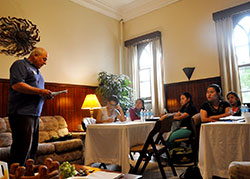Program helps Burmese teach its community ‘in their own dialect’

Ken Ogorek, archdiocesan director of catechesis, leads a session of the Blessed Isidore Ngei Ko Lat Burmese Pastoral and Catechetical Formation Program in the rectory of Sacred Heart of Jesus Parish in Indianapolis on Aug. 9. (Photo by Natalie Hoefer)
By Natalie Hoefer
At 14, Bu Meh of Burma in southeast Asia had lived all but the first year of her life in a refugee camp in Thailand. Her family sought safety there after fleeing unrest in their homeland, now known as Myanmar.
In the midst of growing up in the confined, unsettled existence of a refugee camp, Meh learned her Catholic faith.
After 13 years, her family was resettled to Indianapolis in 2009—facing a new country, a new culture and a new language.
The one consistency in this world of change was her Catholic faith.
“When you have faith, you don’t let someone tell you something is impossible,” said the now 19-year-old. “Through Christ our Lord, all things are possible.”
Meh, a member of St. Pius X Parish in Indianapolis, is one of 15 Burmese young adults learning more about their Catholic faith in English through a new Burmese catechetical program, sponsored by the archdiocesan Office of Intercultural Ministry.
According to Franciscan Brother Moises Gutierrez, director of the office, the program was created to develop pastoral and catechetical leaders for the Burmese population in the archdiocese. It will do so through classes, workshops, lectures and more.
“There are about 500 active Catholic Burmese in Indianapolis,” he said. “But it’s not about numbers.
“Burma is only about 3 percent Catholic, but that makes them so proud and passionate about their faith.
“We want to walk with them and give them the tools to develop a stronger Burmese Catholic community in the archdiocese. The way you teach [Catholics of a different culture] is a little bit different because the language is different, the culture is different.”
The first stage of the program, which started in April and finishes in September, focused on defining the Burmese-American-Catholic identity and the basics of catechesis. Future stages will delve deeper into Catholic teachings, theology and the sacraments.
Most of those participating in the program are in their late teens or 20s, with two in their 30s, said Brother Moises, primarily due to their better command of the English language.
But involvement in the program requires more than just an ability to speak and understand English, he said.
“We went to pastors and pastoral associates,” he explained. “They chose [the participants] not just based on their English, but on their commitment and involvement in the parish.
“They are so excited about getting training. We thought we’d meet once a month, but they wanted to meet twice a month, so that’s what we’re doing.
“In Burma, catechists are held in very high esteem. They were the ones who taught the community. The priest may speak just one dialect. So they teach the catechists and [the catechists] go back and teach the community in their own dialect.”
The full name of the program is the Blessed Isidore Ngei Ko Lat Burmese Pastoral and Catechetical Formation Program.
While Blessed Isidore happens to be the only Burmese person on the path to sainthood, said Brother Moises, “it turns out he was also a lay catechist, and young like these folks when he was martyred.”
The participants come from St. Pius X Parish and St. Mark the Evangelist Parish. The two Indianapolis parishes have the highest concentration of Burmese in the archdiocese.
“They are good people,” said Brother Moises. “They bring new passion, new energy for the Church and for the archdiocese.”
They also comprise a growing presence in the archdiocese, particularly in Indianapolis.
“When we first came to St. Pius [X Parish] in 2010, there were just about 100 Burmese,” said Laurence Saw, a Burmese Catholic involved in the program. “Now we have almost 300 Burmese Catholics there. As the numbers grow, we need to take care of these people.”
The number of Burmese Catholics is growing not just because of resettlement. Brother Moises said 25 Burmese were brought into the Catholic Church just last Easter, most of them adults.
Pae Reh, a member of St. Pius X Parish, became Catholic in 2012, one year after being resettled in Indianapolis.
He participates in the program with his wife, who was Catholic when he met her.
“I want to know more about the faith,” he said. “I want to make my life more perfect. My life is better now with my Catholic faith.”
“Becoming better” is one of the goals of the Office of Intercultural Ministry in general, said Brother Moises.
“The pope and the archdiocese are inviting us to be right there with the people, to have an intercultural encounter,” he explained.
“We walk together and transform each other to become better people and Catholics.
“For me, it’s all about helping to become better Catholics in our own culture.”
(For more information on the Blessed Isidore Ngei Ko Lat Burmese Pastoral and Catechetical Formation Program, contact Franciscan Brother Moises Gutierrez at 317-236-1446, 800-382-9836, ext. 1446, or by e-mail at mgutierrez@archindy.org.) †
